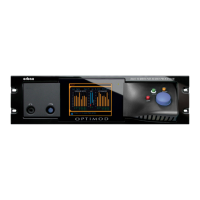3-12
OPERATION ORBAN MODEL 8685
• The second surround sidechain responds to the center channel alone. It provides
both a “compression” and “limiting” function.
The dual-sidechain architecture’s main application is to improve dialog intelligi-
bility by preventing strong energy in the non-center channels from drowning out
dialog in the center channel even when the original mix was miscalculated. To
achieve this, the center channel’s gain sometimes needs to be increased with re-
spect to the other channels and the dialog needs to be re-equalized automati-
cally by multiband compression. Moreover, this dual-sidechain architecture per-
mits the multiband compressor to de-ess center channel dialog as necessary
without affecting the other channels.
Completely independent compression of the dialog channel can cause unnatural-
sounding level imbalances between the dialog and the remaining program ele-
ments. To address this, there are two coupling controls for each frequency band
in the multiband compressor. These coupling controls work by constraining the
difference (in dB) between the center channel’s gain reduction and the main
channel’s gain reduction. To do this, they clamp the center channel’s gain reduc-
tion with respect to the main channel but do not affect the gain reduction in the
main channel. In other words, the center channel’s gain reduction is either the
output of the center channel’s compression sidechain or a fixed offset from the
main channel’s gain reduction. There are separate controls to set the maximum
positive and negative offsets. The constraints are applied to the entire center
gain reduction signal (compression plus limiting).
To preserve intelligibility, it is important to prevent the center channel’s gain re-
duction from becoming too large with respect to the other channels. The B
X
MAIN>CENTER MAX +DELTA GR control sets the maximum positive gain reduction
difference in each band. When the five-band structure is used, it is common to
set this control to 0 dB in Bands 1-3. To facilitate de-essing (and because Bands 4
and 5 in the center channel do not contribute to the gain reduction in the main
sidechain), we recommend setting the B4 and B5 M
AIN>CENTER MAX +DELTA GR
controls to allow some extra gain reduction to occur in center channel Bands 4
and 5. It is OK to set this control to O
FF in Band 5, which allows unconstrained
de-essing above 6 kHz. The TVxxxx factory presets provide examples.
Meanwhile, a B
X MAIN>CENTER MAX –DELTA GR sets the maximum negative gain
reduction difference in each band, which constrains the amount of dynamic dia-
log boost. It also constrains the degree to which the center channel compressor
can pull up noise. If there are program elements other than dialog panned into
the center channel, the control constrains the amount by which the front stereo
image can be narrowed. 3 dB is a typical setting.
• The 2.0 processing architecture is intrinsically dual-mono but allows stereo cou-
pling of the AGC and multiband gain reductions as well as the AGC and compres-
sor gates. If 2.0
PROC MODE control in the CHANNEL page of the active Setup sets is
set to D
UAL MONO, all stereo coupling is turned off and two LOUDNESS LEVEL me-
ters, AGC
GATE indicators, and MB GATE indicators appear.
In S
TEREO mode, there is one LOUDNESS LEVEL meter, AGC GATE indicator, and MB
GATE indicator. However, you can still uncouple each band in both the AGC and
multiband compressors to a variable extent—anywhere from perfect stereo cou-

